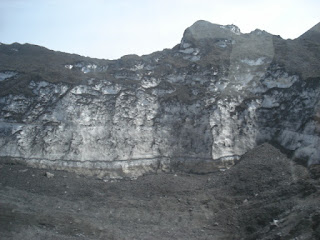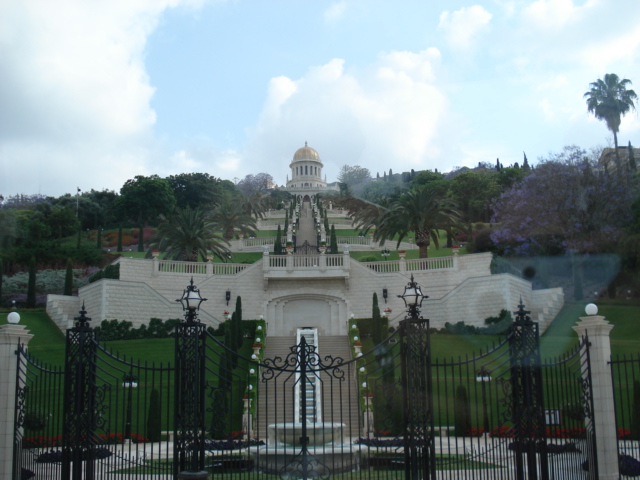No, it's not Rememrance Day, although I used to play "The Last Post" on my bugle every November 11 at the Cenotaph in Burlington. Today is our last blog. Tomorrow we go home: boo hoo! and yea yea!
Today we docked at Sorento, Italy. Sorento is a lovely resort town on the east coast of Italy in a section known as the Amalfi Coast. This is a beautiful section of coastline that has been a vacation area for Italians and particularly Romans for thousands of years.
Here is a shot of Sorento with its coastline of high cliffs looking over the beautiful blue water of the Mediterranean, and our ship anchored in the harbour in the distance.
About 600 BC (2,600 years ago) the Romans built a beautiful resort town near here called Pompeii. For 600 years it was a high-end resort and living community for wealthy Romans, politicians, nobles and notables. After 600 years of development it covered 67 acres, the main street was one mile long, and it had every convenience imaginable, including beautiful homes, running water, sewage disposal, daily garbage pick-up, all types of stores, churches, stadiums, theatres, exclusive clubs, restaurants, etc.
Then, one day, in an instant, it all came to an end. Mount Vesuvius, about 10 kilometres away, erupted in a gigantic volcano. Althouth the lava did not flow as far as Pompeii, volcanic matter from the eruption rained down on the city and literally buried it 15-20 feet deep in ashes mixed with water, extinquishing all life. No one had time to escape. People died right where they were.
No one wanted to rebuild in the same location as they considered it jinxed, so Pompeii was forgotten for 1700 years. It was totally covered with earth and forest. Then one day in 1700 people were digging in the area and discovered some ruins. Since, then 70% of the city has been uncovered, cleaned up, and put on display. It is now a huge tourist attraction. When we arrived this morning about 10am our guide could tell by the ticket numbers we were given that there was already 5,500 visitors there ahead of us, just today. Fortunately, with 67 acres of space, it didn't seem that bad.
Here is the entrance to the city. The road is the famous Appian Way. The small entrance was for the citizens; i.e., the nobles, the owners, etc. The large entrance was for the carts, and the slaves, who did all the work. The nobles and owners did not work; they just lived a life of luxury.
In the centre of the city was the main square, where all the action happened. It is large.
Peggy, the retailer, is standing in front of a row of boutiques in the market square.
We think we may have invented the sliding doors for shops. No way! See the groove in the doorstep to the shop. They had sliding doors back then.
A typical home of a wealthy family had a courtyard,
with beautifully painted walls,
a kitchen,
and a number of tiny bedrooms,
again beautifully painted.
The Romans were big on public baths. However, in Pompeii they were not for the public. They were more like a modern country club. The men went to the bath to spend 2 or 3 hours with their friends, talking business and politics while going through a three-stage bath process: hot bath, steam room and cold shower. The women had their own bath house. Here is a hot bath tub from the men's section.
When the volcano erupted, the people of Pompeii were killed right where they stood or laid. Their bodies were buried in the muddy ash which then hardened to rock. When the bodies decomposed, they left a hollow space in the rock that was an exact mold of the body that had been there. So, when the archeologists discovered this in the 1700's they pumped plaster into the hollow spaces, chipped away the rock, and had an exact replica of the victim at the time of death. Here are a few, including a thinker. Actually, they speculate that he was covering his mouth because of the ash.
Well that's it. It's arrivederci as we leave for the Rome airport early tomorrow and arrive home in the afternoon.
We would lke to thank you for your interest, e-mails, and especially those 8 of you who figured out how to post a comment. Our blog had 1740 page views from Canada, 481 from the US, and 300 others, whatever a page view is.
Wevhave enjoyed putting together these blogs each day, and hope that you have enjoyed looking them over.
Today we docked at Sorento, Italy. Sorento is a lovely resort town on the east coast of Italy in a section known as the Amalfi Coast. This is a beautiful section of coastline that has been a vacation area for Italians and particularly Romans for thousands of years.
Here is a shot of Sorento with its coastline of high cliffs looking over the beautiful blue water of the Mediterranean, and our ship anchored in the harbour in the distance.
From our veranda on the ship we could see Mount Vesuvius some miles up the coast to the north.
About 600 BC (2,600 years ago) the Romans built a beautiful resort town near here called Pompeii. For 600 years it was a high-end resort and living community for wealthy Romans, politicians, nobles and notables. After 600 years of development it covered 67 acres, the main street was one mile long, and it had every convenience imaginable, including beautiful homes, running water, sewage disposal, daily garbage pick-up, all types of stores, churches, stadiums, theatres, exclusive clubs, restaurants, etc.
Then, one day, in an instant, it all came to an end. Mount Vesuvius, about 10 kilometres away, erupted in a gigantic volcano. Althouth the lava did not flow as far as Pompeii, volcanic matter from the eruption rained down on the city and literally buried it 15-20 feet deep in ashes mixed with water, extinquishing all life. No one had time to escape. People died right where they were.
No one wanted to rebuild in the same location as they considered it jinxed, so Pompeii was forgotten for 1700 years. It was totally covered with earth and forest. Then one day in 1700 people were digging in the area and discovered some ruins. Since, then 70% of the city has been uncovered, cleaned up, and put on display. It is now a huge tourist attraction. When we arrived this morning about 10am our guide could tell by the ticket numbers we were given that there was already 5,500 visitors there ahead of us, just today. Fortunately, with 67 acres of space, it didn't seem that bad.
Here is the entrance to the city. The road is the famous Appian Way. The small entrance was for the citizens; i.e., the nobles, the owners, etc. The large entrance was for the carts, and the slaves, who did all the work. The nobles and owners did not work; they just lived a life of luxury.
In the centre of the city was the main square, where all the action happened. It is large.
Peggy, the retailer, is standing in front of a row of boutiques in the market square.
We think we may have invented the sliding doors for shops. No way! See the groove in the doorstep to the shop. They had sliding doors back then.
A typical home of a wealthy family had a courtyard,
with beautifully painted walls,
a kitchen,
and a number of tiny bedrooms,
again beautifully painted.
The Romans were big on public baths. However, in Pompeii they were not for the public. They were more like a modern country club. The men went to the bath to spend 2 or 3 hours with their friends, talking business and politics while going through a three-stage bath process: hot bath, steam room and cold shower. The women had their own bath house. Here is a hot bath tub from the men's section.
When the volcano erupted, the people of Pompeii were killed right where they stood or laid. Their bodies were buried in the muddy ash which then hardened to rock. When the bodies decomposed, they left a hollow space in the rock that was an exact mold of the body that had been there. So, when the archeologists discovered this in the 1700's they pumped plaster into the hollow spaces, chipped away the rock, and had an exact replica of the victim at the time of death. Here are a few, including a thinker. Actually, they speculate that he was covering his mouth because of the ash.
On a happier note, we think we invented Lego. Then what is this?
We would lke to thank you for your interest, e-mails, and especially those 8 of you who figured out how to post a comment. Our blog had 1740 page views from Canada, 481 from the US, and 300 others, whatever a page view is.
Wevhave enjoyed putting together these blogs each day, and hope that you have enjoyed looking them over.
P&G



































































